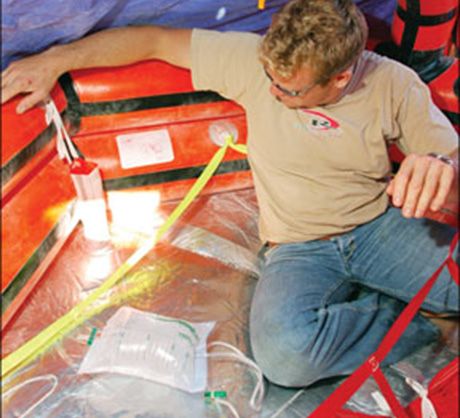
The rescue early this week of Alain Delord, the French single-hander whose boat was dismasted and holed Jan. 18 in the Southern Ocean, after he spent three days in a life raft offers a graphic reminder of the importance of choosing a raft that matches your voyage.
In the age of EPIRBs (Emergency Position Indicating Beacons), it’s easy to lulled into thinking that prolonged life raft ordeals like the one described by Steve Callahan in his classic tale “Adrift” are a thing of the past. Had it not been for the assistance of the Australian Maritime Safety Authority, who dropped Delord a better raft with food, water, and a survival suit, the 63-year-old singlehander might not be alive today. Delord was eventually picked up by a cruise ship that detoured more than 700 miles to rescue him.
Life raft survival kits used by the recreational yachting community can generally be divided into five categories based, in part, on the distance in miles the yacht will be sailing from shore. Types of emergency survival packs include ISO Pack I, ISO Pack II, SOLAS B Pack, Offshore Pack (Type E), and Coastal Pack.

Our recent article on life raft inspections included a comparison of the more common recreational packs.
These basic items include paddles, sea anchor with line, bailer, sponge, bellows or pump, instructions for survival, table of life-saving signals, water bags, leak stoppers, rescue quoit and line, and buoyant safety knife. Additional equipment such as sunscreen, fishing gear, food rations, radar reflectors, and smoke signals depend on the type of recreational life raft survival package as shown in the chart.
The best-stocked survival pack is the SOLAS A Pack-the one that Delord should have been carrying-is meant for commercial vessels operating 50 or more miles from shore. Because it includes more water and food provisions, the SOLAS A Pack weighs significantly more than the other packs.
The May 2007 issue of Practical Sailor took an in-depth look at these packages. In the end, we concluded that none of the standardized packages were ideal. (No raft we tested in 2007 contained a proper radar reflector, a glaring omission in our view.) Even those sailors who have a customized life raft survival kit should be prepared to pack additional gear and supplies in an overboard bag. (We will be looking more closely at ditch kits and their contents in a future issue.)
In addition, none of the rafts we tested came with an EPIRB, SART (search and rescue transponder), or VHF onboard. Winslow provided an EPIRB in its superb abandon-ship kit, but we look forward to the day when EPIRBs are built into the raft. The technology is currently available (U.S. Marines carry satellite-linked PDAs into battle), but putting electronics in wet, harsh conditions takes some serious consideration.
The most common approach today is to include EPIRBs and similar equipment in an abandon-ship kit, but it would be even better if this signaling was as automated as the inflation of the raft itself. The night-time drills held during raft testing convinced testers that in the chaos of an emergency, it is easy to overlook the EPIRB or to fail to bring along a handheld sat-phone kept ready at the nav station.
A life raft that comes equipped with an EPIRB and a comprehensive survival pack will, of course, be heavier and more difficult to stow and launch. Another school of thought emphasizes the importance of keeping the raft light and easy to launch by putting most of the survival equipment in a separate abandon-ship bag. Both arguments have merit, and perhaps a blend of the two philosophies offers the best solution. A belts-and-braces approach would place an EPIRB (and, if the budget allows, a sat-phone) on the boat where its ready for evacuation, and another EPIRB on the life raft itself. If a single EPIRB is the only option, it belongs on the boat in a dedicated location where it is handy during evacuation.
For more on choosing and equipping a life raft, see Survival at Sea Volume I, or our March, April, and May 2007 articles in the archives.

































